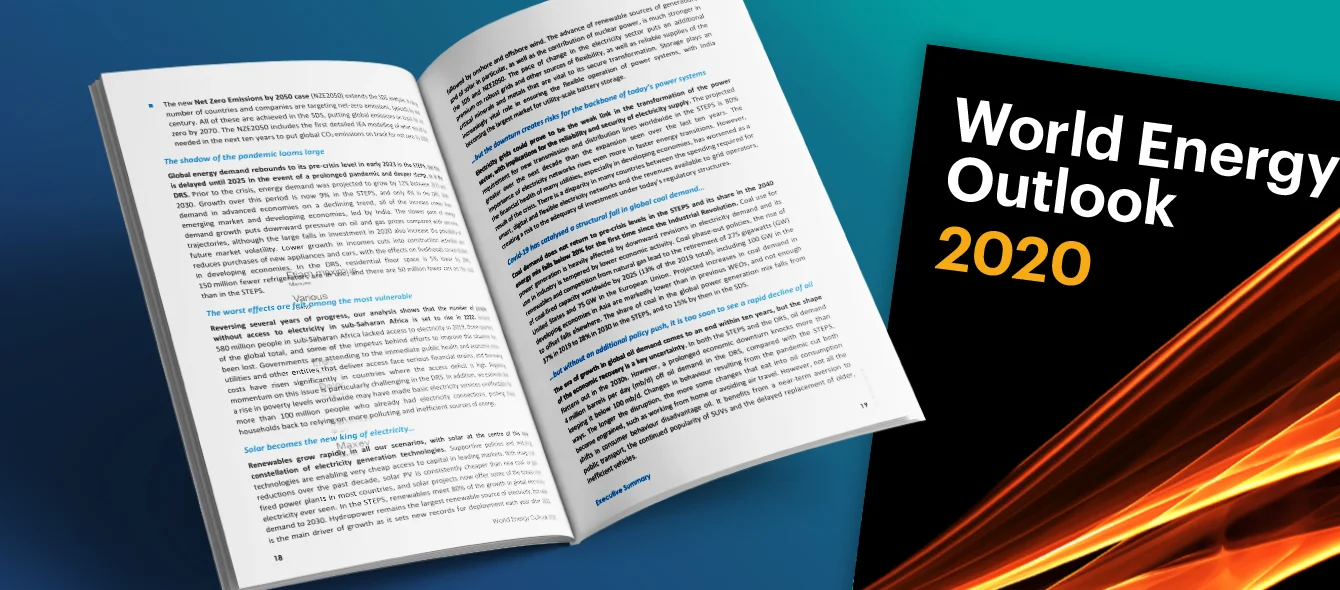It is still too early to know whether the coronavirus represents a setback to sustainable development or a catalyst for change, according to the International Energy Agency’s (IEA) World Energy Outlook (WEO) 2020. The agency estimates that global energy demand will drop 5% this year, energy-related CO2 emissions 7% and energy investment 18%.
It says the pandemic has entrenched a structural downward shift in coal consumption, but warns that slower economic growth is no solution to climate change.
Economic recovery
The speed of economic recovery from Covid-19 is a major uncertainty and cuts both ways, according to the IEA. A slow return to pre-crisis levels of economic activity reduces carbon emissions, but also increases energy poverty and reduces the amount of available investment capital needed to fund the energy transition. Equally, a more rapid recovery increases investment capital, but slows the expected long-term decline in fossil fuel demand. Stronger economic growth supports greater structural change in the energy sector, while a lower growth trajectory leaves economies with higher carbon intensities, the IEA says.
Recovery scenarios
The IEA details different scenarios to illustrate possible pathways out of the coronavirus downturn and onwards to sustainable societies by either 2050 or 2070.
In its Stated Policies Scenario (STEPS), the coronavirus is brought under control in 2021 and energy demand recovers to pre-crisis levels by early 2023. Renewable energy dominates, meeting 90% of expected strong growth in electricity demand. Solar becomes the new “king” of the electricity sector, and, by 2040, coal’s share in global energy demand falls below 20% for the first time in modern history.
Renewable energy capacity according to STEPS scenario (in GW)
Source: IEAIn the Delayed Recovery Scenario (DRS), the same policies are pursued, but it takes until 2023 to get Covid-19 under control and global energy demand does not return to pre-crisis levels until 2025. Oil demand flattens out just below 100 million b/d, 4 million b/d lower than in the STEPS scenario.
However, neither of these scenarios deliver “a decisive break in the trend for global CO2 emissions.”
Sustainable pathways
Radical action is required to meet the IEA’s two sustainable development pathways, the Sustainable Development Scenario (SDS), which would achieve net zero carbon emissions globally by 2070, and the even more ambitious Net Zero Emissions by 2050 (NZE2050). In these scenarios, renewable energy capacity has to accelerate even faster than anticipated under STEPS and DRS. Solar PV and wind power’s share in global generation expands from 8% in 2019 to almost 30% in 2030 under the SDS.
This is underpinned by the dramatic fall in solar PV costs, which the IEA says is now “one of the lowest cost sources of electricity in history.”
Renewable energy capacity according to SDS scenario (in GW)
Source: IEAThe future is electric
Amidst the uncertainty created by the pandemic, the IEA is clear about one aspect of the future — the share of electricity in overall energy consumption will continue to rise.
Modern societies are becoming ever more reliant on electricity and will become more so as a decarbonized electricity sector becomes an ever greater source of energy for transport, heating and potentially hydrogen production. This means that the backbone of the electricity system – the grid – will become much more important. The faster the energy transition is, the greater the demands that will be made upon it.
The IEA warns that inadequate investment in the power system, or an inability to invest owing to financial constraints, could mean electricity grids become a weak link in the energy transition.
Demand trajectories
The policies which governments adopt both to recover from the economic downturn and move towards a more sustainable energy future will have huge impacts on fossil fuel demand and the need for new renewable energy capacity. If policies were implemented consistent with the SDS scenario, oil demand would drop to 66.2 million b/d in 2040, compared with 104.1 million b/d under STEPs.
Global oil demand (in Mio. b/d)
Source: IEANatural gas demand globally has been and is expected to be more resilient, rising from 4,026 Bcm in 2019 to 4,358 Bcm in 2025 and to 5,221 Bcm in 2040 under STEPS. But, in an SDS world, it too sees much reduced demand, rising to 4,166 Bcm in 2025, but then falling to 3,554 Bcm by 2040. In contrast, under all scenarios, wind and solar PV expand rapidly.
Under STEPS, wind capacity leaps from 623 GW in 2019 to 978 GW in 2025 and 1,914 GW in 2040. Under SDS, wind reaches 3,058 GW by 2040. Similarly, solar PV’s growth is huge; from 603 GW in 2019 to either 3,655 GW in 2040 under STEPS or to 5,891 GW under SDS.
Photo credit: shutterstock.com, elxeneize
